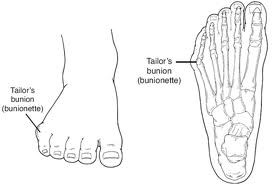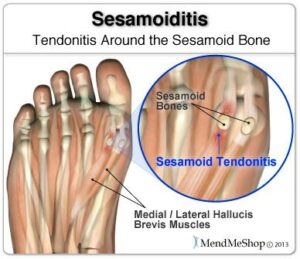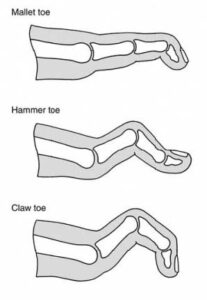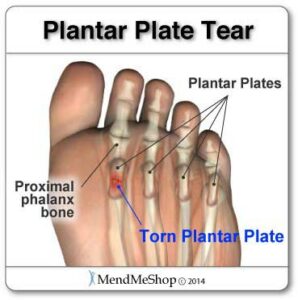Tailor’s Bunion
Tailor’s bunion is a prominence or bump on the 5th toe joint (similar to that of a bunion on the 1st toe). It is usually aggravated by wearing tight shoes, resulting constant pressure and pain. Tailor’s bunion is less common as regular bunion; however, they are similar in cause and symptoms. Tailor’s bunion received its name centuries ago, because it occurred regularly in tailors who sat cross-legged all day with the outside edge of their feet rubbing on the ground.
Symptoms include:
Pain, swelling and redness over the enlarged joint
Risk Factors:
- Irritation of tight or narrow shoes
- Poor biomechanics (eg. Supinated foot)
- Poor footwear (eg. tight toe box)
- Family history
- Bony spur
Assessment – The podiatrists at toe-tal will diagnose the condition through a physical examination and biomechanical assessment, and go through all the necessary treatments listed below to help get you on the right path.
Treatment:
- Apply ICE over the painful area for 15 minutes
- Take non-steroidal anti-inflammatory drugs (NSAIDs) for pain, maximum 7 days
- Wearing the correct socks to reduce bunion pain by reducing the friction by providing cushioning. It is important to choose socks with low friction, so seams over the bunions and cushions over the bunion area from shoe pressure.
- Using a pad (gel or foam) over the bunion deformity
- Footwear advice/modification – avoidance of narrow fitting shoes (talk to the podiatrist at toe-tal about what footwear suits your foot best).
- Orthotic therapy may be prescribed to help protect the joint and redistribute pressure elsewhere
- Corticosteroid injections may help reduce inflammation around joint
- Bunion surgery (of course only after trying all these conservative treatments first)
Sesamoiditis
Sesamoiditis is an umbrella term to describe painful inflammatory condition of the sesamoid bone and surrounding soft tissue, and generally without acute trauma. The two small sesamoid bones are embedded within the tendon under the big toe joint. The big toe takes high force during running and gait, leading to damage the structure around sesamoid bones and cause inflammation.
Symptoms include:
Pain, swelling, stiffness with bending the big toes
Aggravating Factors:
- Excessive forefoot loading
- High heels
- Increase in activity, (and/or decrease in recovery)
- Poor biomechanics (eg. ankle equinus, hallux limitus)
Assessment :
The podiatrists at toe-tal will diagnose the condition through physical examination and biomechanical assessment, and go through all the necessary treatments listed below to help get you on the right path.
Treatment – It is important to follow a rehabilitation program so your injury doesn’t reoccur.
- REST until all pain has resolved (could become permanent damage) – talk to Podiatrist about when you can return to activity). Avoid activities that put weight on the balls of your feet ( Skipping, running), and STOP the activity that is causing the pain. This will give the sesamoids time to heal.
- Take non-steroidal anti-inflammatory drugs (NSAIDs) for pain (if allowed to take) maximum 7 days
- Tape the 1st joint so that it remains slightly downward (plantar flexion). Podiatrist will teach you how to do this
- Correct any biomechanical concerns
- Footwear modification – (the podiatrist at toe-tal will modify your shoes with a shoe pad under the sesamoids in order to redistribute the pressure away from them and to other areas around it)
- Orthotic therapy
- Wear soft soled shoes or out gel insoles in enclosed shoes to provide cushioning and relieve stress
- Return to activity gradually, also wearing cushioned pad to support the sesamoids
Msllet Toe, Hammer Toe & Claw Toe
Mallet toe, hammer toes and claw toe are three main forms of toe deformities in the foot.
Mallet toe is characterized by the downward bending the third joint of the lesser toe, presenting a mallet-like appearance.
Hammer toe refers to upwards pulling the first joint and downward bending of the second joint of the toe, commonly affecting second and third toe. This results in high pressure on the ball of the foot. Low-arch feet normally develop hammer toes.
Claw toe is described as upwards pulling the first joint and downward bending of the second and third joint of the toe, usually involving all the lesser toes. More pressure is on the end of the claw toe. Claw toes are commonly seen in high-arched feet.
Risk Factors:
- Muscle imbalance
- Foot type (eg. High arch and low arch)
- Poor footwear
Symptoms include:
- Corns on the top or end of the toe
- Callous on the ball of the feet
- Pain in any joints of the toe
Assessment – The podiatrists at toe-tal will diagnose the condition through a physical examination and biomechanical assessment, and go through all the necessary treatments listed below to help get you back on the right path.
Treatment:
- Footwear advice/modification – (talk to the podiatrist at toe-tal about what footwear suits your foot best).
- Wear protective padding on corns and callous
- Debridement of callous and corns from a health professional (Podiatrist at toe-tal podiatry can deride dead skin safely)
- Do exercises regularly (eg. Soft tissue extension and intrinsic muscle exercises)
- Use splints or straps to realign the affected toes (Podiatrist will make customized ones)
- Orthotics (whether off the shelf, prefabricated or customized)
- Surgery
Plantar Plate Tear
Plantar plate tear is described the pain and swelling in the ball of foot, commonly affecting the 2nd toe joint. The plantar plate is to protection the ball of the foot from pressure and prevent from over extending toes. It tends to affect middle-age women who have pronated feet. It also related to hammer toes and bunions.
Symptoms:
- Localized pain under the ball of feet
- Pain aggravated when bend the affected toe
- Swelling on the top of foot
Risk Factors:
- Poor biomechanics (eg. excessive pronation)
- Excessive forefoot loading
- Longer 2nd metatarsal bone
Assessment:
The podiatrists at toe-tal may diagnose the condition through clinical tests (including A-P drawer test) and biomechanical assessment, and go through all the necessary treatments listed below to help get you on the right path. As it is complex anatomical region, if necessary, further investigations such as ultrasound and MRI are required to assess the severity of the condition.
Treatment:
- REST until all pain has resolved (could become permanent damage) – talk to Podiatrist about when you can return to activity (will be gradual and initially activity may be modified)
- Plantar flexion strapping of the digit
- Take non-steroidal anti-inflammatory drugs (NSAIDs) for pain, maximum 7 days
- Accommodative padding to offload area
- Orthotic therapy
- Wear stiff-soled or rocker- bottom shoes
- Correct biomechanics
- Corticosteroid injection
- Surgery to repair tear
Contact Us.
Please contact the appropriate location for bookings.
Salisbury Medical Centre
PH: 3277 1621 - Fax: 3277 2887
ACE Sports Medicine – Hibiscus Sports Complex
PH: 3349 5733 - Fax: 3349 5122
Acacia Ridge Day And Night Chemmart Pharmacy
PH: 3277 4220 - Fax: 3255 5644
Brisbane Medical Specialists – Tarragindi
PH: 3184 0400 - Fax: 3892 7094
Morningside General Practice Clinics – Morningside Plaza
PH: 3399 4685 - Fax: 3395 7377
Any other enquiries please email info@toetalpodiatry.com.au or call 0422 389 652
